How to teach a puppy basic commands? Training a puppy is an excellent way to strengthen the bond and ensure the dog’s good behavior and joyful attitude.
The most important aspect is to begin the teaching process as soon as possible, with pleasure and never hankering after consistency.
This article covers the most fundamental aspects of teaching puppies the necessary commands step-by-step. Let’s get started!
How to Teach Your Puppy Basic Commands With 12 Key Commands
Here are 12 basic commands:
1. Teach Your Puppy Their Name
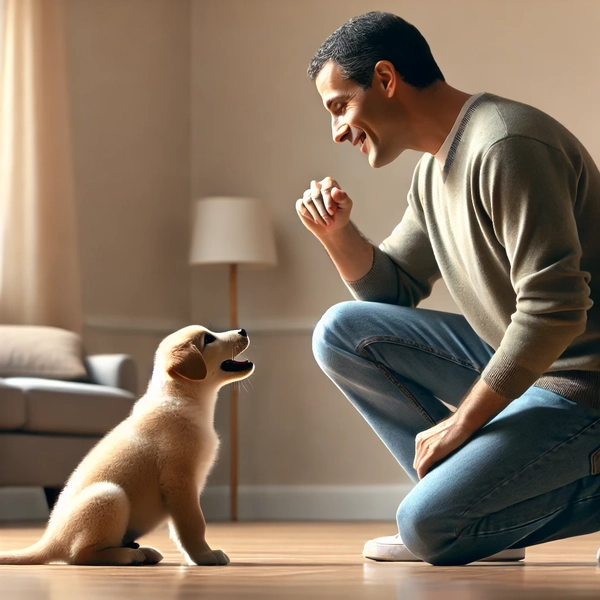
Think of how a child’s parent calls them by their name so they can respond.
Step-By-Step Guide to Train Their Name:
- Step 1: Address your puppy using their name in a warm and loving voice.
- Step 2: Reward them with a treat or say “well done” when they pay attention to you.
- Step 3. Carry this out a couple of days each day in different places to enable them to understand it faster.
It’s advisable to book a less cluttered space that won’t have much noise so your puppy can listen to you.
2. Come Command
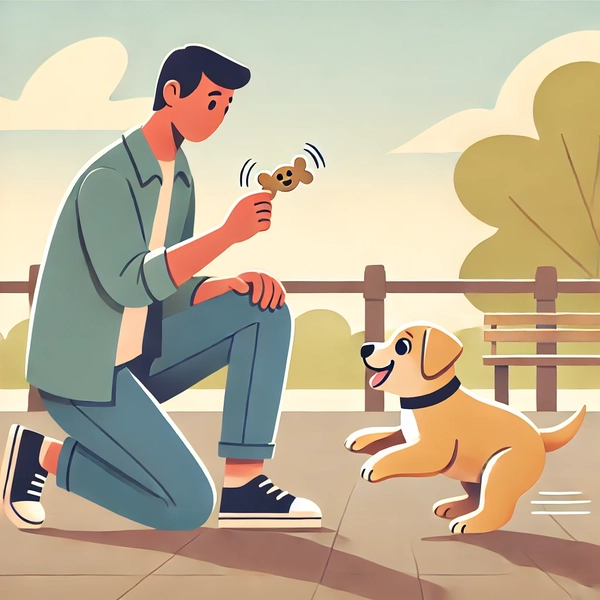
It is, however, trainable to teach your puppy to come when called, which is essential for their safety. Whether your puppy is at home or the park- they should always come when called.
How to Teach the ‘Come’ Command:
- Step 1: Place your puppy on a leash, then have a target, such as a delicious treat or a favorite toy.
- Step 2: After the puppy’s name, scream ‘come!’ or ‘come!’ in a ‘Come!’ tone, then slightly pull the dog by the leash when necessary.
- Step 3: When your dog comes to you to say hi, be rewarded with petting and treats.
- Step 4: Do the exercise in different Locations so they know it is significant, but sometimes, they will do it with distractions still present.
Note: Always motivate the dog to follow the command. Remember that dogs are more likely to be obedient when happy during the session!
3. Sit Command
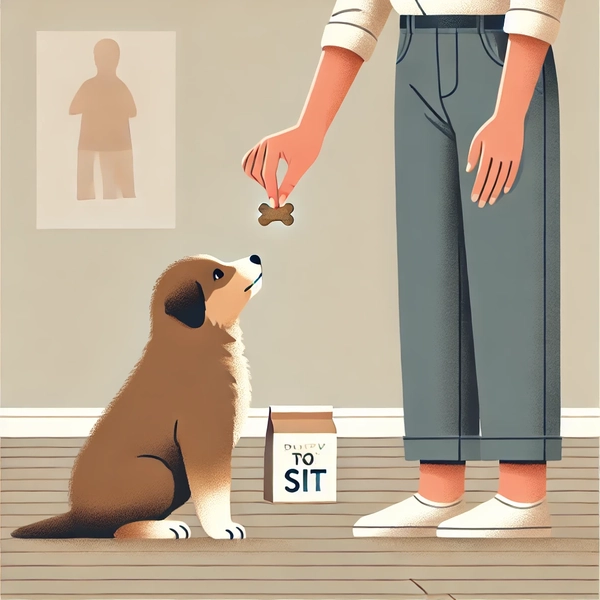
It’s excellent for calming a puppy down and making them focus.
Teaching Your Puppy to Sit:
- Step 1: Hold a treat above your puppy’s nose and slowly move it upwards.
- Step 2: While their head turns to your moving treat, they will settle down.
- Step 3: The moment they sit, and their rear end contacts the floor, say “Sit” and then provide them with the treat.
- Step 4: Practice the same until you can give the sit command without using the treat as a bribe.
Hint: Do not despair should the puppy refuse to do it; just avoid the lesson once and resume later. Different puppies understand easily differently.
4. Stay Command
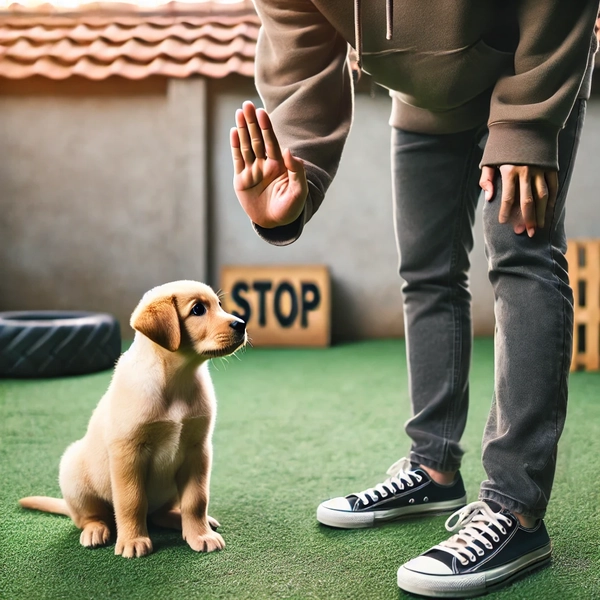
The stay command is also useful for teaching any puppy patience. It is a good tool for preventing a dog from succumbing to temptation when there is much fun going on in the background.
Instructions for Teaching “Stay”:
- Step 1: Tell the puppy to sit.
- Step 2: Extend your palm in the direction and say, “Stop.”
- Step 3: Stand a little away, and if the puppy remains still, every food item followed by praise can be used to reward him.
- Step 4: Start to increase the gap and the duration. Do this by starting with a few seconds and then adding time.
Do not: Do not give up. Some dogs do not want to stay. Continue to focus on the aspect, and it will eventually improve.
5. Leave It Command
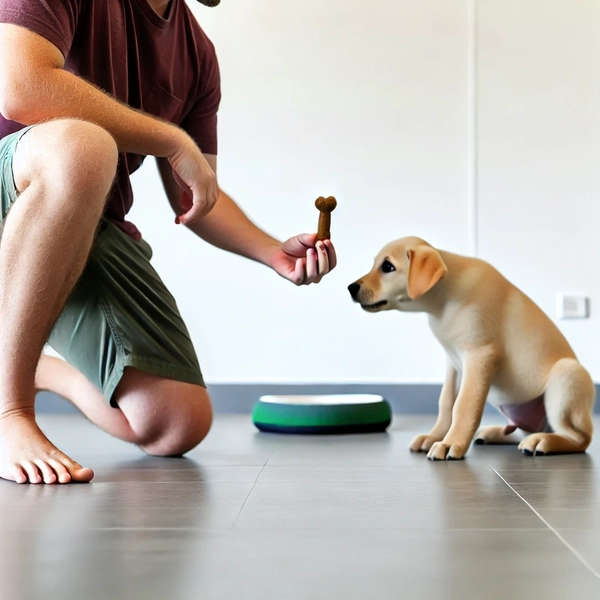
The “Leave It” command is key to protecting your pup from destroying objects or eating what it is not supposed to.
Teaching: ‘Leave it’’ Command”
- Step 1: Put an inexpensive treat in your palm and let the puppy smell it. Tell it to ‘leave it’.
- Step 2: When it stops sniffing or when it loses interest, present a better treat from the other hand.
- Step 3: Allow it to do so until they are able to initially leave without substantively escalating the “leave it ” voice.
- Step 4: When doing the above steps with treats is okay, introduce the object or item it usually likes to go to, grab, and repeat the commands.
Be sure to have puppy training graduation during practicing sessions. They begin to learn to understand the world, and the more it is safe, the better.
6. Down Command
Enabling the “Down” command is essential when managing a problematic puppy, especially in situations with too much action.
How to Teach ‘Down’:
- Step 1: Begin by placing your puppy in a sitting position. Grab a treat close to its nose before lowering it to the ground.
- Step 2 – If your puppy follows the treat and lies down, say ‘Down’ and immediately reward them.
- Step 3—Repeat several times. If they don’t lie down at once, then they should have a high energy level to be able to practice only a few repetitions at a time.
Never physically push or force your puppy down. Allow them the chance to lie down on their own!
7. Wait Command
The “Wait” command helps in teaching your puppy patience and control. Going, especially when a door is open, satisfies your puppy.
Steps to Teach ‘Wait’:
- Step 1: Hold the puppy’s leash near a door.
- Step 2: While opening the door slightly, say, “Wait.” Once they try to proceed, kindly shut the door.
- Step 3: Depending on their response, start wedging the door further and state, “Okay, go on, ” to let the puppy out.
Step 4: Ideally, various areas should be used so that the instruction is understood.
Make a habit of using this command. Ensure she respects it as not sparingly; only walking or playing requires a wait.
8. Watch Me Command
The “Watch Me” command is particularly useful when raising puppies. It ensures that they pay attention to you, thereby making it easier for you to teach other commands.
How to Teach ‘Watch Me’:
- Step 1 – Place a treat close to your puppy’s mouth and gradually bring it to your face while sounding “watch me.”
- Step 2 – Whenever your puppy looks at you, reward it immediately.
- Step 3 – When you have practiced this enough in one situation, go to another one where there are distractions and help your dog focus on you.
The command is compelling before you attempt to teach them another command.
9. Heel Command
Teaching the “Heel” command involves calming your puppy down and walking by your side. This skill is helpful for outings in a park or along busy thoroughfares.
Guide on How to Teach “Heel”:
- Step 1: Have the puppy walk beside you while holding attention by offering a threat and saying,” Let’s heel.”
- Step 2: If the puppy lacerates ahead of you, stop moving and call the puppy back again.
- Step 3: Once the pup stays calm and walks without pulling, praise them accordingly.
- Step 4: Conduct the sessions for short periods at first, with extended walking periods scheduled as proficiency increases.
- Tip: Remember to make the walks enjoyable. Recall that baby canines have a short attention span!
10. Off Command
This command is to be taught to the puppy to restrict its actions, especially when it is inappropriate to jump onto furniture or people.
Teaching the ‘Off’ Command:
- Step 1: Anytime the puppy goes up, and you disapprove, “Off” should be countered in an affirming yet not harsh tone.
- Step 2: Temptation is for you to encourage the puppy to step down by placing a treat in front of them.
- Step 3: Once Task 2 is undertaken, rewards and encouragement should be given when the puppy starts to get down.
- Step 4: Do this as often as possible until the puppy understands that a “keep paws down” command will follow once it jumps up.
Remember to use the command EVERY time the dog jumps because that is the only way they will learn quickly.
Here are two more commands to get the 12 significant commands in the list for training the puppy.
11. Stand Command
The “Get Up” command should be learned for medical reasons or to groom the dog, especially when it is supposed to stand. It is also used to perform a body checkup on the dog.
How to teach it ‘Get Up’ Command’:
- Step 1: Start with the dog sitting down.
- Step 2: Shield about the command standing up.
- Step 3: Proceed to step 3 when the dogs pick up or stand up and reward and praise the same.
- Step 4: Repeat this process until they fully understand and know what is expected of them in the following command, “Sit,” by standing and getting up by themselves.
Note: It’s better to begin in a calm female area and, after a while, gradually
12. Drop It Command
Advantages: This particular command is designed for the safety of any puppy. If a puppy picks up potentially dangerous things, the “leave it” command helps to prevent them from chewing on them and keeps them off the track while playing.
The command “Drop It,” also known as ‘Leave It,’ has the same purpose as ‘Cease Control Behavior.’ It prevents any behavior from children and animals at any point in time from ‘All Play.’
Introduction to the Command “Leave It”
- Step 1: Expend time throwing things and catching them with the toy they use. While holding it in their mouth, they will take the toy and say, ‘Drop it.’
- Step 2: Incite the pet by showing a tidbit or edible to get it to relinquish the toy. The instance the toy comes off, offer the edible to them.
- Step 3: MakRepeatis exercise often until the pet drops anything on command, which might not necessarily mean seeing a tidbit is necessary.
Reminder: The command in question may help the owner and the pets and dogs in question. Training is recommended to use the command’s important information immediately.
You can add hours and a rate for each training. The number of commands taught using dog tactics will now be 12, with the two added commands involving the “Leave it alone.”
Basic Puppy Training Mistakes
Now, let’s look at most people’s mistakes, leading to failure while training their dogs. These mistakes can easily be avoided:
| Mistake | Why It’s a Problem |
| Waiting Too Long | Puppies learn best when training starts early. |
| Lack of Routine | Consistency helps puppies feel secure and confident. |
| Too Much Independence | Unsupervised puppies may develop bad habits. |
| Scolding or Yelling | Negative reactions create fear and confusion. |
Think positive and give them a chance. Puppies don’t mature overnight, so don’t exert too much pressure on them.
Puppy Training Tips & Tricks
Below are more pieces of advice that should help enhance the effectiveness of the training in question.
- Use Positive Reinforcement: Give food items and use kind words to reward the good behavior.
- Be Patient. Puppies have short attention spans, so they should be trained slowly. Thus, educational classes should be up to an hour in length.
- Order Other Commands: with this approach, each separate command will include a clear and concise way to phrase the performance.
Even simple obedience work should have a progression, like a ladder that goes step by step without omitting any, so that all instructions are included.
Make it a point to end a training session so the puppy is interested and willing to participate in the next one. Okay?
Training a puppy is a rather demanding occupation, requiring much time, power of endurance, and sweat.
It is a pleasure to teach a puppy simple tasks such as “Come,” “Sit,” “Stay,” and other valuable tricks or commands that can improve this pet’s personality.
Clients are reminded that with time, the puppy will grow up and become a grown dog that could key itself to their lifestyle in one way, shape, or form. Hence, they are encouraged to be patient. They also need to start doing something else once the session ends.
Are you all set to do the most exciting work: teaching your little pet? Be quick. Take something to nibble on, go somewhere quiet, and prepare the pet how to shake hands or perform other easy tricks!